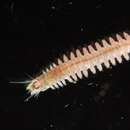en
names in breadcrumbs


Nereis is a genus of polychaete worms in the family Nereididae. It comprises many species, most of which are marine. Nereis possess setae and parapodia for locomotion and gas exchange.[1] They may have two types of setae, which are found on the parapodia. Acicular setae provide support. Locomotor setae are for crawling, and are the bristles that are visible on the exterior of the Polychaeta. They are cylindrical in shape, found not only in sandy areas, and they are adapted to burrow. They often cling to seagrass (posidonia) or other grass on rocks and sometimes gather in large groups.
Nereis worms are commonly known as rag worms or clam worms. The body is long, slender, and dorso-ventrally flattened, reaching a length of 5-30 cm. The head consists of two parts: a roughly triangular anterior lobe—the prostomium—and a posterior ring-like portion—the peristomium.[2] The latter bears four pairs of tentacular cirri, dorsally two pairs of eyes, and ventrally a pair of short two-jointed palps.
The scientific Latin genus name Nereis derives from the Ancient Greek Νηρηΐς : Nērēís (stem Νηρηΐδ- : Nērēid), a sea nymph.
Nereis are osmoconformers. They are dioecious (individuals are male or female) and they release their haploid gametes into the water, a process called spawning. Moreover, upon fertilization and mitotic divisions of the zygote, Nereids form a larval stage which is similar to that of molluscs – i.e. a trochophore larva.
The genus Nereis contains the following species:[3]
Nereis is a genus of polychaete worms in the family Nereididae. It comprises many species, most of which are marine. Nereis possess setae and parapodia for locomotion and gas exchange. They may have two types of setae, which are found on the parapodia. Acicular setae provide support. Locomotor setae are for crawling, and are the bristles that are visible on the exterior of the Polychaeta. They are cylindrical in shape, found not only in sandy areas, and they are adapted to burrow. They often cling to seagrass (posidonia) or other grass on rocks and sometimes gather in large groups.
Nereis worms are commonly known as rag worms or clam worms. The body is long, slender, and dorso-ventrally flattened, reaching a length of 5-30 cm. The head consists of two parts: a roughly triangular anterior lobe—the prostomium—and a posterior ring-like portion—the peristomium. The latter bears four pairs of tentacular cirri, dorsally two pairs of eyes, and ventrally a pair of short two-jointed palps.